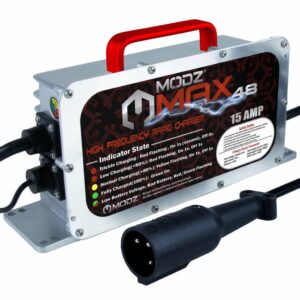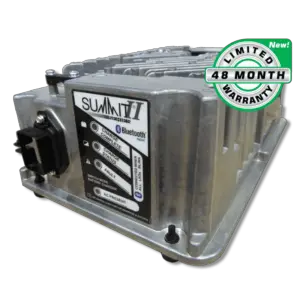If you own a club car, you’d probably be in a situation where your car battery is not charging or drains quickly.
Common reasons why club cars may have charging issues are either due to a faulty charger, a damaged power cable, or a dead battery.
Read on for a list of symptoms and solutions for your club car charging problems.
Your Battery Is Weak or Drain Out Fast
After a full charge, an average club car battery should have a run time of 30 miles for a 36-volt battery configuration and between 40-45 miles for a 48-volt battery configuration.
Low battery voltage causes the fuel pump to be slower in delivering fuel to the internal combustion engine. This, in turn, causes the car to accelerate slowly.
How to Check Your Battery Voltage Output
It should be a routine practice to check the voltage output of your battery. This can be done in a few steps with an analog or digital multimeter or voltmeter.
- Charge your battery until fully charged.
- Set up the multimeter to read up to 20 DC volts.
- Connect the positive of the multimeter to the positive terminal of the battery, and negative to negative.
- While the engine is running, check the voltage reading on your connected meter.
- Repeat these steps for the number of batteries present in the compartment.
Multiply the number of holes, 3, 4, or 6, you see in the battery compartment by two to determine the standard battery’s voltage. For example, a 6 volt per battery, 36-volt configuration system will have 3 holes and requires 6 batteries.
When the battery voltage reading is lower than the product standard, it’s a sign that your charging system performance starts to decline and needs attention.
Other reasons may include:
- Alternator undercharged
- Worn out battery
- Bad or wrong terminal connection
How to Fix Low or Weak Battery Voltage
A battery with low voltage output will require a charge boost.
Step 1: To boost your club car batteries, charge up an individual 12V or pairs of 6V batteries in series with a regular 12-volt car charger (not for a golf cart). For 8V batteries, you can charge them in pairs just like two 6V batteries.
Step 2: Connect negative and positive lead terminals of the car charger on the respective terminals of each club car battery. When charging 2 batteries in series, just connect the charger to one battery’s positive and the next battery’s negative.
Step 3: Charge in 10 to 20 minutes. This process should have boosted your club car battery up to its standard voltage output.
Step 4: Repeat the process for all batteries.
Step 5: Charge your batteries with your Club Car charger.
Find purchasing options for 36V/ 48V Club Car Charger at Amazon:

MODZ Max48 48V 15 Amp

FORM 36V 18 Amp

Lester Link Series 48V 13 Amp
NB: Don’t leave the batteries unattended while doing this.
When charging batteries individually, you also need to perform an On-Board Computer Reset (OBC) by unplugging the pack negative cable for more than 10 minutes for the charging system to work correctly.
No “Click” Sound after Plugging in The Charger. What Can I Do?
If you plug in the charger and no click sound is heard, the problem is either that the battery voltage is too low (less than 35 DC volts) or there is a problem with the OBC or a fuse.
Check the voltage output and fix if it’s low, as discussed on how to solve the low voltage problem above.
If there’s a problem after fixing the voltage, try to bypass the On-Board Computer.
If the bypassing process works, this is a strong indication of a damaged OBC. When you determine the OBC is the reason causing the charging issue, you can fix it in one of the following ways:
- Replace a new OBC.
- Buy a new charger that can charge your club car battery without the Onboard Computer component.
A new OBC is pricey, so a new smart charger (DPI Smart charger) may be your best bet.
Buy Smart Charger for your Club Car battery here:

Accusense 18A
36V Smart Charger

Lester Summit 36V/48V Smart charger
Loose or Wrong Wire Connection
For a battery to start a car, it’s crucial for the positive and negative cable to be well connected to complete a circuit.
The negative battery cable provides the ground connection. It is usually connected to the vehicle frame, while the positive is bolted to the starter kit or fuse box.
What a loose wire connection means for charging is that the flow of current will be interrupted, and the battery won’t get charged.
Steps to Diagnose a Loose Wire Connection
Follow the steps below to check the reasons why the wire to terminal connection is not tightly fixed.
- Open the battery compartment, usually found in the front.
- Check if the negative and positive battery cables are connected to their right terminal.
NB: Red cable should be connected to the ‘+’ terminal, and the black negative cable should be connected to the ‘-‘ battery terminal.
- Check if you can easily pull the battery wires off of the battery terminals, then that indicates loose tightening.
How to Fix a Loose Cable-to-battery Terminal Connection
Here a few ways you can solve an untightened cable problem:
- Tighten the slacked battery cable with a socket or a screwdriver designed to fit on the bolt at the battery terminals.
- For a slacked terminal bolt, fit a lead battery post shims to fix the battery cables in position.
- Buy new battery terminals to completely replace a worn-out one.
Find the right type of Battery Terminal Clamp you should buy at Amazon:

Fastronix Military Battery Terminal

Cllena Military Battery Terminal
How to Fix Overcharging Problem Caused by Wrong Ground Wiring
An incorrect ground wiring fault will translate to an overcharged battery. As the charger starts to supply the wrong amount of charge even when the voltage regulator is intact.
Follow the steps below to diagnose the wrong ground wiring:
- Disconnect the yellow cable connector coming off the voltage regulator.
- While unplugged, check the running voltage reading with a voltmeter.
- The voltage should start around 12 volts and drop slightly as it runs since the circuit should be incomplete
- If the voltage increases when the yellow lead is disconnected and the car is running, this is a strong indication of a short-circuit to the ground.
To fix the car club grounding problem, trace the gray ground wires to make sure they’re not connected in any way to the frame of the golf cart or other metal.
Problem With Battery Charger and Plug
The first step is to choose a battery charger, and plug type that suits your club car model. Most of the electric golf cars fall into two categories: Automatic and Non-Automatic types.
You can check through the club car’s manual for the right type to buy.
After you might have chosen the right charger as well as the plug type, the other three most common reasons why your battery may not charge are:
Timer Units
The knob is meant for switching the charger ON or OFF and allows you to set the hours the charger will stay on.
A damaged timer unit will not allow the charger to stop charging at the set time. When a charger runs overtime, it reduces the average lifespan of the battery
Diodes
These are charger components that convert alternating current from the grid to a direct current form to be stored in the battery.
A faulty diode means the current will not flow through the charger to the battery.
Diodes are best replaced when bad.
Spoilt DC Plug
These are connectors for supplying direct current (DC) through the charger to the battery.
A faulty plug may appear melted with a rough contact face. It may also charge irregularly. Once these symptoms persist, the plug should be replaced to avoid damage to the battery.
See DC Plug for Club Car Charger at Amazon:

Panglong 48V Charger DC Cord Plug

Accusense Battery Charger Connector
Other Common Reasons Causing Club Car Charging Problem
- Faulty transformers
- Damaged Fuses
- Failed voltage regulator
FAQs
How do you know if your golf cart charger is faulty?
There are no rules of thumb to know this. You can simply try your charger on another golf cart to check if it works.
When this is not feasible, connect a voltmeter to its positive and negative clips to check the amount of power the battery generates.
Should I leave my golf cart plugged in all the time?
This is a bad practice as it can damage the diode and transformer of the charger. It also causes the battery to be overcharged, reducing the average lifespan by several years.
How do I know if my club car charger is working?
If the OBC is working without flaws, the charger’s relay should make a “click” sound when plugged in. An absence of a click sound is not sufficient to tag the charger damaged.
The problem may be either with the OBC, fuse, or low battery voltage.
Can you overcharge golf cart batteries?
Your cart battery can charge too much. When the timer unit is damaged. Continuous charging reduces the lifespan of the cells.
